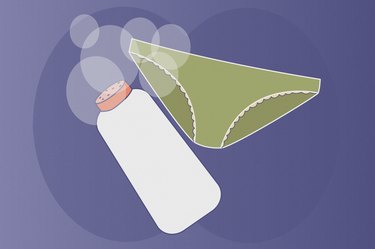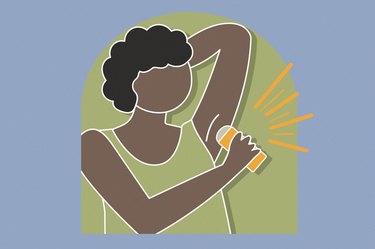
Over the past several years, you may have seen hair-raising headlines sounding the alarm about a possible link between using talcum powder (the main ingredient in many baby powder products) in your V-zone and cancer. And yet, last year a meta-analysis suggested there was no association between the two. Still, lots of people have questions and concerns about the risks.
We dug into the research and quizzed experts in the field to bring you the most complete picture of what the science says about talcum powder and ovarian cancer.
Video of the Day
Video of the Day
First, What Is Talcum Powder?
According to the U.S. Food & Drug Administration (FDA), talc is a naturally occurring mineral, mined underground. Found in clay, it is the softest mineral on earth. It's commonly used in cosmetics, where it soaks up moisture and odors, prevents caking and gives products a silky texture. It's also used as a filler for plastics, paper and construction materials.
Some people assigned female at birth (AFAB) use talcum powder for feminine hygiene, sprinkling it on their genitals, underwear, pads, diaphragms or tampons. The goal is to soak up sweat and moisture, reduce odors and prevent irritation and friction.
The Link Between Talc and Asbestos
Asbestos is a group of mineral fibers that are resistant to heat and corrosion, per the Occupational Safety and Health Administration (OSHA). Thanks to these properties, they were frequently used in the past as building materials, from pipe insulation to floor tiles.
Today asbestos is recognized as a health hazard and carcinogen. Breathing it in can lead to lung disease and cancer. The Environmental Working Group (EWG) estimates that asbestos kills 12,000 to 15,000 people a year in the U.S.
So, what does talcum powder have to do with all this? Well, since the 1970s, people have voiced concerns that talc might potentially be contaminated by asbestos. According to the Environmental Working Group (EWG), talc is mined from rock that commonly contains asbestos. Therefore, strands of asbestos might be present in raw talc.
Tests done by the EWG, published November 2020 in Environmental Health Insights, found that 14 percent of talc-based cosmetics contained asbestos, while FDA testing revealed that 21 percent of cosmetics with talc also had traces of asbestos.
Can Talcum Powder Cause Ovarian Cancer?
Clear links have been found between asbestos exposure and ovarian cancer, according to the American Cancer Society. However, the most complete and recent data does not support a connection between sprinkling talcum powder south of the border and ovarian cancer.
In a January 2020 JAMA analysis, researchers compiled data from four studies including more than 250,000 people who identified as women. Thirty-eight percent of them reported they had used powder in the genital area. Of those, 10 percent had been using it for at least 10 years and 22 percent used it at least once a week. The researchers determined there was not a statistically significant association between powder use and ovarian cancer risk.
One of the hypotheses for how you get ovarian cancer is that toxins travel up the cervix, through the fallopian tube and out into the ovaries. This theory stems from the fact that if you have your tubes tied (a hysterectomy, in other words), disrupting the connection between the outside world and your ovaries, you are less likely to get ovarian cancer.
But your cervix is very good at stopping material from passing through your vagina and protecting your insides. It's sort of like a nightclub bouncer: Your cervix seals off the rest of your reproductive system, allowing only semen to enter and menstrual blood to exit.
That said, there's still a possibility of trace amounts of powder traveling into your ovaries. "Let's say you douse your genital area in talcum powder and then put in a tampon," says Melissa Hardesty, MD, gynecologic oncologist at Alaska Women's Care, member of the medical and scientific advisory board of the National Ovarian Cancer Coalition. "You could potentially get some in your vagina."
Still, even if a bit of powder managed to make its way into your ovaries, to date there is no scientific evidence showing it leads to cancer. "One in four cases of ovarian cancer are caused by a hereditary predisposition," Dr. Hardesty says. "The other causes are not well understood."
4 Tips for Using Talcum Powder Safely
1. Undies First, Then Powder
Do you ever dust on powder to wick away perspiration or prevent chafing and moisture-related rashes? If you want to play it super safe, slide on your undies beforehand to create a barrier.
"Since moisture typically appears in the leg creases and tummy fold, put your panties on first and then put on talcum powder," Dr. Hardesty says. "Underwear would hugely diminish any potential transit that could be occurring."
2. Sprinkle It Lightly
Use the minimum amount of powder needed. "Don't dump it on," Dr. Hardesty says. "If you have so much moisture that you need to apply it multiple times a day, consult with a dermatologist or gynecologist — they might suggest a prescription powder."
3. Switch to Cornstarch
Some companies are phasing out talcum powder in favor of cornstarch-based powder, so you could consider changing the product you use.
Dr. Hardesty doesn't think that's necessary, though. "You can use cornstarch if you're worried, but I don't think we need to start a campaign to get rid of talc in all products and have it replaced with cornstarch," she says. "The evidence is not that compelling."
4. Talk to Your Doctor
If you're turning to powder to deal with smells or discharge, talk to your ob-gyn or primary care provider. "Do not self-medicate," says Ivy Wilkinson-Ryan, MD, gynecologic oncologist at Dartmouth-Hitchcock. "Your genitals should be left alone unless instructed by your physician."
So, How Bad Is It Really to Use Talcum Powder in Your Genital Area?
There is no proven cancer link, so it's probably OK. "As a physician who treats ovarian cancer, I occasionally use these products," Dr. Hardesty says. "It's a testament of my own digestion of the literature that I am willing to expose myself to that."
But as a general guideline: If you have any bothersome symptoms or concerns about the health of your honey pot, call your provider instead of DIY doctoring!
- FDA: "Talc"
- OSHA: "Asbestos"
- Environmental Health Insights: "Asbestos Contamination in Talc-Based Cosmetics: An Invisible Cancer Risk"
- EWG: "Asbestos kills 12,000-15,000 people per year in the U.S"
- EWG: "EWG-Commissioned Tests Finds Cancer-Causing Asbestos in Talc-based Cosmetics"
- FDA: "FDA In Brief: FDA Releases Final Report of Talc-containing Cosmetic Products Tested for Asbestos"
- J&J: "Johnson & Johnson Consumer Health Announces Discontinuation of Talc-based Johnson’s Baby Powder in U.S. and Canada"
- JAMA: "Association of Powder Use in the Genital Area With Risk of Ovarian Cancer"
- American Cancer Society: "Asbestos and Cancer Risk"
Is this an emergency? If you are experiencing serious medical symptoms, please see the National Library of Medicine’s list of signs you need emergency medical attention or call 911.



